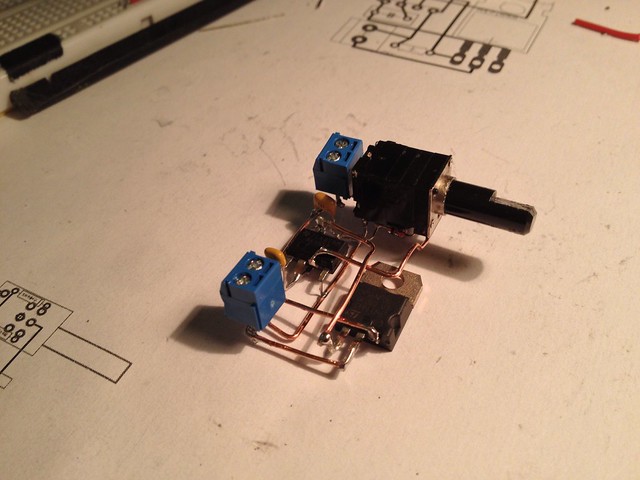It's a dimmer circuit: a 555-timer-based PWM generator driving a high power MOSFET. I kept it simple and focused on a method, not on making anything particularly fancy.
Here's a video walk-through of the circuit:
I edited a schematic for a board I'd built earlier, adding a scrounged 10k audio potentiometer with switch. The parts list was short:
- 10k potentiometer with switch,
- 2 2-pin screw terminals (input and output),
- NE555 8-pin chip,
- fat npn MOSFET,
- 2 1N4148 diodes,
- 2 capacitors: .1uF and 1uF,
- 330 ohm resistor
- Put the major components where you want them first.
- Pack the rest of the components in paying attention to keeping traces short.
- Small 2-lead components can fit later, with one lead overlapping its signal, the other reached by a branch made from its lead.
- Lay out a few long traces that hit the most pins and cover the most ground first. Try to get those traces in a straight line or aligned in an L- or S- or U- arrangement, more or less.
- Avoid branching, unless the branch can be a component's lead.
- Small kinks and zig-zags are OK and may be built with straighter wire segments later, with pins bent to get where they need to be.
- Don't think much about top/bottom layering and about crossing lines. There will be room to cross a wire here or there. Try not to cross, but you can worry about top and bottom later.
- Print out a sheet to see the circuit different ways, to use as a pattern. Run the same sheet through the printer, taking advantage of the print options:
- Aligned top center, scale 2 or 3 (what will fit), with all layers drawn.
- Aligned lower left, scale 1, with all layers,
- Aligned lower right, scale 1, just the traces.
- Note: also print scale 1 mirrored versions too, of all layers and traces only, to see things from the bottom, which is how things are soldered.
- In the trace-only print-out, number the longest traces to make wires for them.
- Strip a length of stripped solid-core wire for each long trace. Bend them to shape with pliers, clipping to length, using the trace-only print as the pattern.
- Small kinks in the pattern don't generally need to be bent-- wires and pins will bend during soldering.
- Clip leads after soldering, unless it has to butt up as a T. It's easy to clip after soldering, and wires can shift during soldering.
I'm looking forward to using this on a few other cicruits, maybe a PIC-based USB-serial converter, or a multichannel MOSFET-based switcher or SSR or... good stuff from this :) Then there's the question of how to mount this, or cast it in some material.


Just a small remark: A TIP121 is a Darlington and not a Mosfet.
ReplyDeleteHere is an interesting read, I found a bit ago:
http://forums.parallax.com/showthread.php?71139-Darlington-Transistor-vs.-MOSFET
Thanks, good link! I'll edit the text, I'm using a MOSFET.
DeleteDo you have the schematic for it?
ReplyDeleteI am looking for a nice simple, small sized PWM circuit to control LEDs
Sorry I don't have it handy now, but it's nothing fancy-- just a schematic I found that looked like so many others :) This looks similar:
Deletehttp://www.pcbheaven.com/circuitpages/LED_PWM_Dimmer/